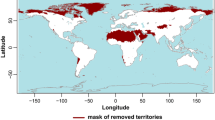Abstract
Climate change would increase the risk of floods or droughts. So far, only a few studies have projected changes in extremes on a regional or local scale. None of these studies relied on multiple climate proxies. Only some studies have started to estimate the exposure to flooding or drought as a proxy of risk; so, here, we present an exercise in risk analysis. Studies of climate change and its impacts rarely yield consensus on the distribution of exposure, vulnerability or possible outcomes. In addition, Northeast Brazil (NEB) is known for its temporal and spatial variability of rainfall and several studies have investigated this variability in order to understand damaging episodes such as droughts and floods. In NEB, the phenomenon of drought is a complex issue because millions of people are affected, and so, it is an important object of study in various fields of knowledge. One way of trying to argue about this phenomenon is through the concept of vulnerability. In this preliminary study, one will determine the risk or exposure factor to drought, which is one component of vulnerability, mainly concerning agricultural activities. The drought risk/exposure indicator was constructed based on three indices: the standardized precipitation index (SPI), the precipitation concentration period (PCP) and the precipitation concentration degree (PCD). The exposure indices showed an increase in high values from 1979 to 2008. On the contrary, the period from 1967 to 1996 showed that the risk factor in some micro-regions had low indices in a larger number; one can note that the dynamics of the factor is in an evolution between high and extremes.






Similar content being viewed by others
References
Adger, W. N., Brooks, N., Bentham, G., & Agnew, M. (2004). New indicators of vulnerability and adaptive capacity (p. 128). Oslo
Al, J. E. T. (2006). The New Hadley Centre Climate Model (HadGEM1): evaluation of, (2005), 1327–1353
Antwi-Agyei P, Fraser EDG, Dougill AJ, Stringer LC, Simelton E (2012) Mapping the vulnerability of crop production to drought in Ghana using rainfall, yield and socioeconomic data. Appl Geogr 32(2):324–334. doi:10.1016/j.apgeog.2011.06.010
Brooks N, Neil Adger W, Mick Kelly P (2005) The determinants of vulnerability and adaptive capacity at the national level and the implications for adaptation. Glob Environ Chang 15(2):151–163. doi:10.1016/j.gloenvcha.2004.12.006
Cardona OD (2003) The need for rethinking the concepts of vulnerability and risk from a holistic perspective: a necessary review and criticism for effective risk management. In Mapping vulnerability: disasters, development and people. Earthscan Publishers, London
CEPED UFSC (Ed.). (2011). Atlas Brasileiro de Desastres Naturais 1991 a 2010 Vol. Rio Grande do Norte (p. 57). Florianópolis
Duggins J, Williams M, Kim D-Y, Smith E (2010) Changepoint detection in SPI transition probabilities. J Hydrology 388(3–4):456–463. doi:10.1016/j.jhydrol.2010.05.030
Ferreira AG, Mello NGS (2005) Principais Sistemas Atmosféricos Atuantes Sobre a Região Nordeste Do Brasil e a Influência dos Oceanos. Rev Bras Climatol 1(1):15–28
Füssel H-M(2010) How inequitable is the global distribution of responsibility, capability, and vulnerability to climate change: a comprehensive indicator-based assessment. Glob Environ Chang 20(4):597–611. doi:10.1016/j.gloenvcha.2010.07.009
Hufschmidt, G., Crozier, M., & Glade, T. (2005). Evolution of natural risk : research framework and perspectives, (1967), 375–387
IBAMA (Instituto Brasileiro do Meio Ambiente e Recursos Naturais Renováveis) (2011). CECAV - Centro Nacional de Estudo, Proteção e Manejo de Cavernas. Núcleo do Rio Grande do Norte. Diagnóstico espeleológico do Rio Grande do Norte: caracterização geográfica do Rio Grande do Norte. Natal – RN. Available at: www.ibama.gov.br/cecav/download.phpid_download=292. Accessed 11 Jan 2011
IBGE (Instituto Brasileiro de Geografia e Estatística) (2010) Sistema IBGE de recuperação automática de dados. Available at: www.sidra.ibge.gov.br/. Accessed 19 May 2010
IPCC (2007) Summary for policymakers. In: Solomon S, Qin D, Mamming M, Chen Z, Marquis M, Averyt KB, Tignor M, Miller HL (eds) Climate change 2007: the physical science basis. Contribution of working group I to the fourth assessment report of the intergovernmental panel on climate change. Cambridge University Press, Cambridge, United Kingdom and New York
Kienberger S, Lang S, Zeil P (2009) Spatial vulnerability units – expert-based spatial modelling of socio-economic vulnerability in the Salzach catchment, Austria. Nat Hazards Earth Syst Sci 9(3):767–778. doi:10.5194/nhess-9-767-2009
Li, X., Jiang, F., Li, L., & Wang, G. (2010). Spatial and temporal variability of precipitation concentration index, concentration degree and concentration period in Xinjiang, China. International Journal of Climatology, 1693(June 2010), n/a–n/a. doi:10.1002/joc.2181
Mckee, T. B., Doesken, N. J., & Kleist, J. (1993). The relationship of drought frequency and duration to time scales, (January), 17–22
Paavola J (2008) Livelihoods, vulnerability and adaptation to climate change in Morogoro, Tanzania. Environ Sci Pol 11(7):642–654. doi:10.1016/j.envsci.2008.06.002
Paulo AA, Ferreira E, Coelho C, Pereira LS (2005) Drought class transition analysis through Markov and Loglinear models, an approach to early warning. Agric Water Manag 77(1–3):59–81. doi:10.1016/j.agwat.2004.09.039
Shukla J, Nobre P (1996) Variations of sea surface temperature, wind stress, and rainfall over the Tropical Atlantic and South America. J Climate 9:2464–2479
Simelton, E., Fraser, E. D. G., Termansen, M., Forster, P. M., & Dougill, A. J. (2009). Typologies of crop-drought vulnerability: an empirical analysis of the socio-economic factors that influence the sensitivity and resilience to drought of three major food crops in China (1961–2001), 12, 438–452. doi:10.1016/j.envsci.2008.11.005
Thomaz, C., Costa, C., Oliveira, M. A. J. De, Accioly, L. J. D. O., & Silva, F. H. B. B. (2009). Análise da degradação da caatinga no núcleo de desertificação do Seridó (RN/PB) Analysis of degradation of “Caatinga” in the desertification nucleus of Seridó - Brazil, (21), 961–974
Wagner RG (1996)Decadal-scale trends in mechanisms controlling meridional sea surface temperature gradients in the tropical Atlantic. J Geophys Res 101(7):683–694
Wilhelmi OV, Wilhite DA (2002). Assessing vulnerability to agricultural drought: a Nebraska case study. Natural Hazards 25(1):37-58
Zhang L, Yongfu Y (2003) Annual distribution features of precipitation in China and their interannual variations. Acta Meteorol Sin 17(3):146–163
Author information
Authors and Affiliations
Corresponding author
Rights and permissions
About this article
Cite this article
Silva, B.K.N., Lucio, P.S. Characterization of risk/exposure to climate extremes for the Brazilian Northeast—case study: Rio Grande do Norte . Theor Appl Climatol 122, 59–67 (2015). https://doi.org/10.1007/s00704-014-1275-z
Received:
Accepted:
Published:
Issue Date:
DOI: https://doi.org/10.1007/s00704-014-1275-z




